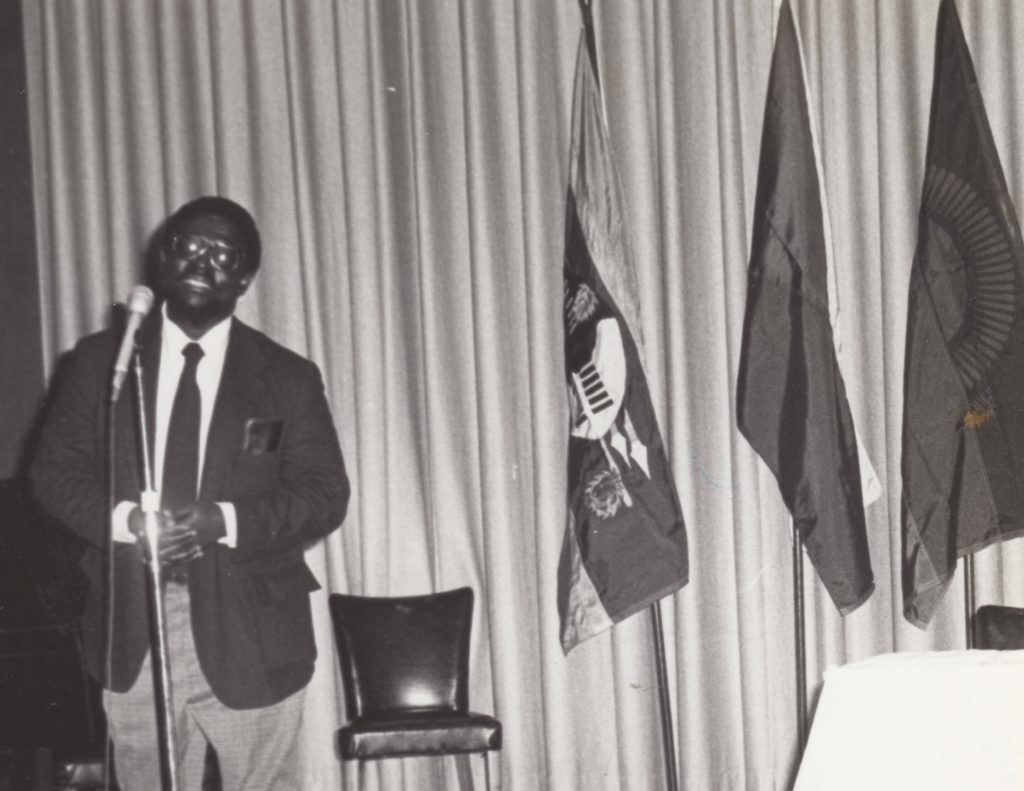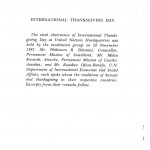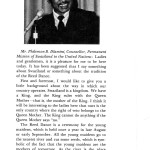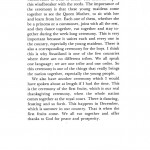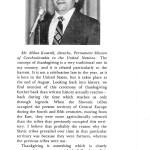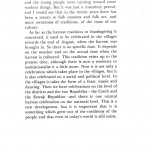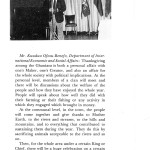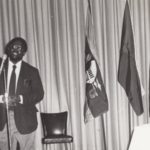The sixth observance of International Thanksgiving Day at United Nations Headquarters was held by the meditation group on 20 November 1981 .
Mr. Philemon B. Dlaminz, Counsellor, Permanent Mission of Swaziland; Mr. Milan Kovarik, Attache, Permanent Mission of Czechoslovakia: and Mr. Kwadwo Ofosu-Benefo , UN Department of International Economic and Social Affairs (from Ghana) each spoke about the traditions of harvest and thanksgiving in their respective countries.
Excerpts from their remarks follow.
Condensed From text printed in Bulletin Peace Meditation at the UN 1981 Vol 09 No 11-12, Page 30-36
Mr. Philemon B. Dlaminz, Counsellor, Permanent Mission of Swaziland to the UN. The King rules with the mother of the King. The King cannot do anything if the Queen Mother says “no.” In late August or early September. young maidens go to the Queen Mother’s court, sit with her and learn from her. Each one of them, whether princess or a commoner and stay together during the week-long ceremony. There is also a corresponding ceremony for boys. First fruits is our thanksgiving ceremony. When the whole nation comes together at the royal court in December, when first fruits come, we all offer thanks to God for peace and prosperity.
Mr. Milan Kovarik, Attache, Permanent Mission of Czechoslovakia; to the UN. Thanksgiving is a very traditional and related to the harvest at the end of August. We find mention of this ceremony of thanksgiving further back through legends. When the Slavonic tribes occupied the present territory of Central Europe, they were more agriculturally oriented than the tribes that previously occupied this territory. Thanksgiving is closely connected with folk culture. There has been a return to folk customs and art, and more awareness of traditions, the roots of our culture. Harvest tradition or thanksgiving celebrated towards the end of August when the harvest is collected – not only takes place in villages but is also on a social and political level which grew out of traditions.
Mr. Kwadwo Ofosu-Benefo, U.N.Department of International Economic and Social Affairs
(from Ghana) . Thanksgiving among the Ghanaians is both a personal affair with one’s Maker, one’s Creator, and also for the society. A clan will meet about welfare of the people and the year, how they did farming, fishing or any activity. At communal level, in town people will together give thanks to Mother Earth, rivers and streams, hills and mountains, and everything that contributed to sustaining them. Under a certain King or Chief, there will be a huge celebration on a day to offer thanksgiving to their gods. Some celebrations observed before the advent of Christianity in Africa are still enjoyed by all the people, especially the children. An opportunity to eat delicious meals, shout and show they are grateful to the gods and goddesses, the priests and priestesses, their elders, and their parents.
Full text as printed in Bulletin Peace Meditation at the UN 1981 Vol 09 No 11-12, Page 30-36
Mr. Philemon B. Dlaminz, Counsellor, Permanent Mission of Swaziland to the United Nations: Ladies and gentlem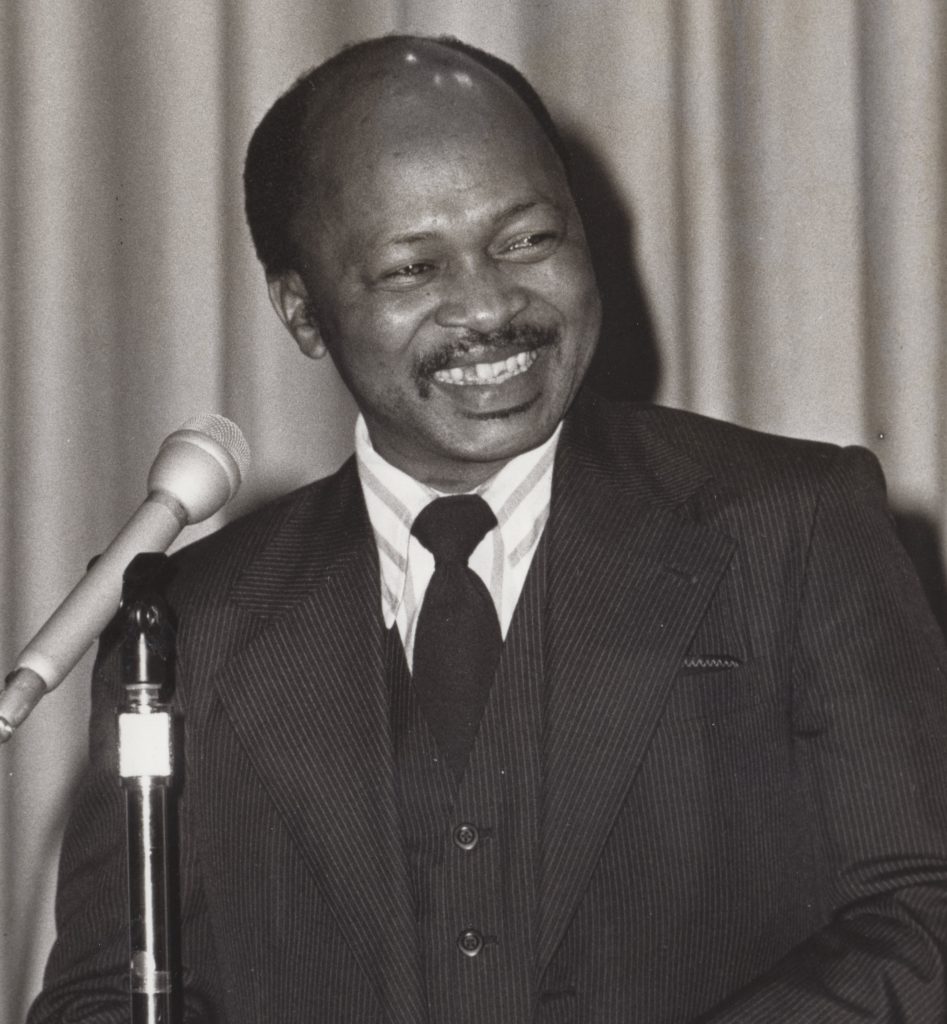 en, it is a pleasure for me to be here today. It has been suggested that I say something about Swaziland or something about the tradition of the Reed Dance. First and foremost, I would like to give you a little background about the way in which our country operates. Swaziland is a kingdom. We have a King, and the King rules with the Queen Mother-that is, the mother of the King. I think it will be interesting to the ladies here that ours is the only country where the right of veto belongs to the Queen Mother. The King cannot do anything if the Queen Mother says “no.”
en, it is a pleasure for me to be here today. It has been suggested that I say something about Swaziland or something about the tradition of the Reed Dance. First and foremost, I would like to give you a little background about the way in which our country operates. Swaziland is a kingdom. We have a King, and the King rules with the Queen Mother-that is, the mother of the King. I think it will be interesting to the ladies here that ours is the only country where the right of veto belongs to the Queen Mother. The King cannot do anything if the Queen Mother says “no.”
The Reed Dance is a ceremony for the young maidens, which is held once a year in late August or early September. All the young maidens go to the nearest river and cut some reeds, which is symbolic of the fact that the young maidens are the mothers of tomorrow. As the river is the place where the reeds grow, even so these young maidens 31 are going to bear the children of tomorrow. They take these reeds and go to the Queen Mother’s court, where there are small beehive houses with a windbreaker in front of them. The maidens repair this windbreaker with the reeds. The importance of the ceremony is that these young maidens come together to see the Queen Mother, to sit with her and learn from her. Each one of them, whether she be a princess or a commoner, joins with all the rest, and they dance together, eat together and stay together during the week-long ceremony. This is very important because it unites each and everyone in the country, especially the young maidens. There is also a corresponding ceremony for the boys. I think this is why Swaziland is one of the few countries where there are no different tribes. We all speak one language; we are one tribe and one order. So this ceremony is one of the things that really brings the nation together, especially the young people.
We also have another ceremony which I would have spoken about at length if I had the time. This is the ceremony of the first fruits, which is our real thanksgiving ceremony, when the whole nation comes together at the royal court. There is dancing, feasting and so forth . This happens in December, which is summer in our country . That is when the first fruits come. We all eat together and offer thanks to God for peace and prosperity.
 Mr. Milan Kovarik, Attache, Permanent Mission of Czechoslovakia; to the United Nations. The concept of thanksgiving is a very traditional one in my country, and it is related particularly to the harvest. It is not a celebration late in the year, as it is here in the United States, but it takes place at the end of August. Looking back into history, we find mention of this ceremony of thanksgiving further back than written history actually reaches back during the time which reaches us only through legends. When the Slavonic tribes occupied the present territory of Central Europe during the fourth and fifth centuries, moving from the East, they were more agriculturally oriented than the tribes that previously occupied this territory. I believe that probably the reason why the Slavic tribes prevailed over time in that particular territory was because they were farmers, whereas the previous tribes were not.
Mr. Milan Kovarik, Attache, Permanent Mission of Czechoslovakia; to the United Nations. The concept of thanksgiving is a very traditional one in my country, and it is related particularly to the harvest. It is not a celebration late in the year, as it is here in the United States, but it takes place at the end of August. Looking back into history, we find mention of this ceremony of thanksgiving further back than written history actually reaches back during the time which reaches us only through legends. When the Slavonic tribes occupied the present territory of Central Europe during the fourth and fifth centuries, moving from the East, they were more agriculturally oriented than the tribes that previously occupied this territory. I believe that probably the reason why the Slavic tribes prevailed over time in that particular territory was because they were farmers, whereas the previous tribes were not.
Thanksgiving is something which is closely connected in our country with the folk culture. It is a happy circumstance that even after all the upheavals in modern history, in this century in particular, the folk customs in my country are still being preserved. There was a time, say in the early fifties, when there was a period of social change and the young people were turning toward more modern things. But it was just a transitory period, and I would say that in the recent years there has been a return to folk customs and folk art, and more awareness of traditions, of the roots of our culture.
As far as the harvest tradition or thanksgiving is concerned, it used to be celebrated in the villages towards the end of August, when the harvest was brought in. So there is no specific date. It depends on the weather and on the actual time when the harvest is collected. This tradition exists up to the present time, although there is now a tendency to institutionalize it a little more. Now it is not only a celebration which takes place in the villages, but it is also celebrated on a social and political level. In the villages it takes the form of a feast, music and dancing. Then we have celebrations on the level of the districts and the two Republics – the Czech and the Slovak Republics – and there is one central harvest celebration on the national level. This is a new development, but it is important that it is something which grew out of the traditions of the people and that even in today’s world it still exists.
Mr. Kwadwo Ofosu-Benefo, U.N.Department of International Economic and Social Affairs, Mr. Kwadwo Ofosu-Benefo, Department of international Economic and Social Affairs: Thanksgiving among the Ghanaians is both a personal affair with one’s Maker, one’s Creator, and also an affair for the whole society with political implications . At the personal level, members of a clan will meet and there will be discussions about the welfare of the people and how they have enjoyed the whole year. People will speak about how well they did with their farming or their fishing or any activity in which they engaged which brought in money. At the communal level, in the town, the people will come together and give thanks to Mother Earth, to the rivers and streams, to the hills and mountains, and to everything that contributed to sustaining them during the year. They do this by sacrificing animals acceptable to the rivers and so on. Then, for the whole area under a certain King or Chief, there will be a huge celebration on a certain day. All the people will gather with the Chief or King to offer thanksgiving to their gods and . The priests and priestess will dance and divine was to what will happen during the coming year with regard to rain, drought, the fertility of the people and so on.
This the description of some of the celebrations observed before the advent of Christianity in Africa that still continue today. Ghanians haven’t lost these tractions , and they are still enjoyed by all the people, especially the children, because it is an opportunity for them to eat huge, delicious meals, to dance and shout in the street and to do all sorts of things to show that they are grateful to the gods and goddesses, the priests and priestesses, their elder, their parents and so on.
Each spoke about the traditions of harvest and thanksgiving in their respective countries.
Gallery:
